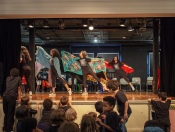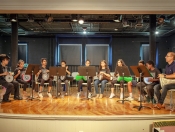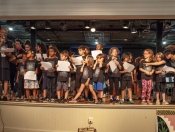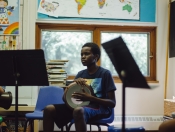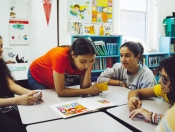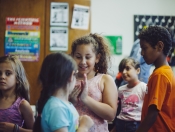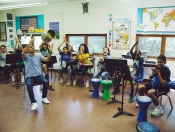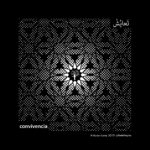
From July 8 to 19, 2019, fifty campers ages 4-14 took part in an amazing and fun-filled two-week program held at St. Peter’s School. Through this summer’s theme about Al-Andalus, campers explored the idea of co-existence (convivencia/ta’ayush) while learning about the art, science, stories, dance, and music of this thriving era of cross-cultural and multi-faith exchange in the 8th to 15th century Iberian Peninsula. They learned about how such ideas relate to our lives today as a model for co-existence. Our campers were as diverse as the era — from Arab and non-Arab heritage with multiple faiths and nationalities represented, they got to experience first hand a culturally diverse and enriching environment.
Enjoy photos taken by our staff, Joseph Fuentes, and Chip Colson:
In Lisa Volta-Zalloum’s Science Class, campers learned about acoustics and sounds. They experimented with sounds and how sound waves reflect off of architecture, they built an amplifier for their cell phones and a tonoscope to observe sound wave vibrations. The campers also learned a lot about important scholars and scientists and their work. For 11th century Ibn al-Haytham they learned about his illumination problem theory about the direction of light and they built their own camera obscura out of an extra classroom. Everyone loved distilling rosewater to make perfume and essential oils based upon the works of the 9th century scholars Al-Kindi and Jabir ibn Hayyan. Lastly they drew plants from life based upon the works of the 13th century scientist, Ibn al-Baitar, on the medicinal uses of plants.
Lisa Volta-Zalloum also taught Art Class, where campers learned about Al-Andalus through studying the Alhambra, a beautiful palace/fort in Granada. They transferred geometric patterns onto tiles where they also wrote Arabic words which are found in the stone and wood carvings of the Alhambra. They then used a glaze based on the popular lusterware pottery of the period. In the spirt of convivencia/tayaush the campers also made a collaborative piece where they gathered patterns based on their identities to create a collage. For the showcase performance they also studied the manuscript illustrations of the from the 13th century love story The Narrative of Bayad and Riyad, designed and created the sets, and then posed on stage as the scenes from the illustrations depicted.
In Hafez Kotain’s Percussion Class, campers learned the basics of Arab drumming techniques on the doumbek while each group also learned a call-and-response and a solo piece using rhythms from across the Arab world which they performed beautifully at the end-of-camp showcase.
In Farnaz Perry’s Arabic Class, campers had an immersive experience in Arabic as they learned about objects and key vocabulary related to the natural and cultural world of Al-Andalus, including fruits and vegetables and terms from the various groups that thrived in Iberia during this period. They practiced Arabic conversation, watched Arabic film clips, and learned Arabic songs such as Fil-Bustan and Yalli Zaratu which they performed at the end-of-camp showcase.
In Denise Valentine’s Storytelling Class, campers learned and shared stories focused on the convivencia/tayaush. They explored traditionally Ashanti stories in order to gain an appreciation for the diversity and interconnectedness of all Life. They explored stories from around the world that recall the wisdom of living together or symbiosis such as the Baobab Story, Aesop to Ananse, and Scheherazade and the 1001 Nights. In the process they learned the components of storytelling, how to analyze, appreciate, and create stories for others and themselves. During the camp celebration, a group narrated parts of the 1001 Nights.
In Rafi Levin’s Improv Class, campers learned the core principles of improv such as intentionality, mindfulness, and flexibility, while learning about overcoming obstacles and challenges while supporting each other. The exercise, such as tongue twisters, and the skits the campers put on built their confidence and self awareness while they explored their identities and picked up a few specific skills like how to project or work as a team. During the camp celebration, a group presented an improv they had developed called the ABC Time Capsule where they explored ideas about coexistence.
In David Heayn-Menendez’s Dance Class, campers learned about body movements, embodying the space, and the cultural history of dance while learning samah, an originally Syrian Sufi dance, and flamenco, an Andalusian dance born from the cross cultural interaction of southern Iberia. Each group learned both dances and performed at the end-of-camp showcase.
Every year there are so many fun great camp moments — this year was no exception! ALF SHUKR – A Thousand Thanks to all the counselors, staff, families, and children who participated and made this program possible. We could not do this without you!
Al-Bustan Camp is supported by University of Pennsylvania Middle East Center, John K. and Elizabeth W. Knorr Charitable Foundation, Philadelphia Cultural Fund, and individual donors. ALF SHUKR for your support!
References on Al-Andalus:
Lunde, Paul. The Science of Al-Andalus. Saudi Aramco World, 2004.
Menocal, María Rosa. The Ornament of the World. Back Bay Books. 2002.
Patricia, Countess Jellicoe. The Art of Islamic Spain. Saudi Aramco World, 1992.
Dunlop, Fiona. Andaluz: A Food Journey Through Southern Spain. Interlink Publishing Group. 2018.
Cities of Light: The Rise and Fall of Islamic Spain
The Met: Artistic Interaction among Cultures in Medieval Iberia
Podcast: History of Philosophy without any gaps: Philosophy’s Reign in Spain: Andalusia


